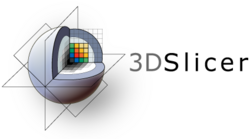Slicer3.2:Training
From NAMIC Wiki
Home < Slicer3.2:Training
Welcome to the 3D Slicer3 Tutorial Page
This page is under construction The information on this page applies to 3D Slicer version 3. If you are looking for materials about Slicer version 2, please go to the following location.
|
Slicer Logo | |
Software Installation
The Slicer download page contains links for downloading the different versions of Slicer 3.
Training Compendium
| Level | Tutorial | Sample Data | Image |
| 1 | Data Loading and Visualization in Slicer3 | SlicerSampleVisualization.tar.gz | 
|
| 1 | EM Segmentation Course EMSegmenter Mini-Tutorials |
AutomaticSegmentation.tar.gz EMSegTutorial-AHM2008.zip |

|
| 1 | Registration in Slicer 3 | ||
| 2 | Slicer3 Course for Developers
This tutorial is intended for engineers and scientists who want to integrate external programs with Slicer3. |
HelloWorld.zip | 
|
| 2 | Neurosurgical Planning in Slicer3
Demonstrate's Slicer3's IGT capabilities by using image registration, model making and DTI to create a preoperative plan for neurosurgery |
ImageGuidedTherapyPlanning.pdf | 
|
| 3 | Slicer3 as a research tool for image guided therapy research (IGT)
This tutorial is intended for engineers and scientists who want to use Slicer 3 for IGT research. |

|
- Level 1 = Basic functionality
- Level 2 = Advanced functionality
- Level 3 = Specialized application packages
Additional Materials
For a variety of data sets for downloading, check the following link.
Back to Training:Main
